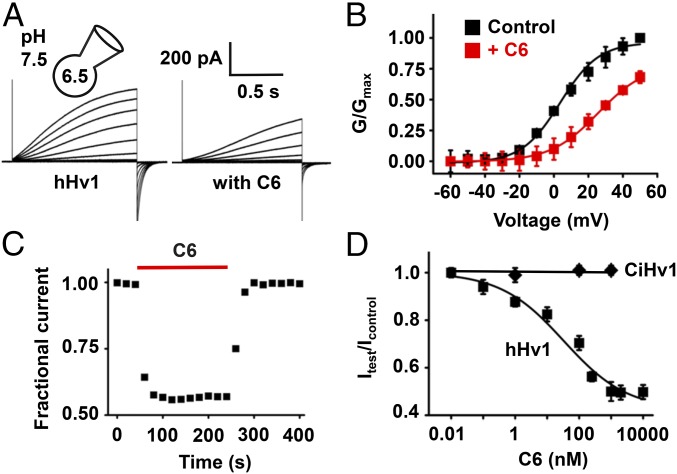Fig. 3.
C6 specifically inhibits hHv1 proton currents. hHv1 and CiHv1 channels were expressed in HEK293T cells and studied by whole-cell patch clamp to assess block parameters using a holding voltage of −80 mV, 1.5-s test pulses, and a 10-s interpulse interval, with pHi = 6.5 and pHo = 7.5. Values are mean ± SEM; n = 6–12 cells for each condition. (A) Representative proton current traces for hHv1 channels before (Left), and in the presence of 250 nM C6 (Right) with steps of 10 mV from −80 to 50 mV. The tail current measured immediately following depolarization was used to determine the extent of block. Fitting the activation and deactivation of proton currents at 40 mV to a single exponential function gave time constants τact of 1,528 ± 116 and 2,183 ± 173 ms, τtail of 109.2 ± 12.4 and 67.8 ± 9.0 ms without and with C6, respectively. (B) Conductance–voltage relationships (G–V) for hHv1 (■) in the absence or presence of 250 nM C6 (red, ■). Curves are fitting to the Boltzmann equation. (C) The time course for block and unblock of hHv1 on acute application (red bar) and washout of 250 nM C6. Currents were recorded at 40 mV. (D) Dose–response relationships for C6 inhibition of hHv1 (■) and CiHv1 (♦). The inhibition constant Ki of C6 for hHv1 channels was estimated from the fit to Eq. 1 and was 30.9 ± 3.4 nM with a Hill coefficient of 0.48 ± 0.04; the maximum inhibition by C6 at +40 mV was 50% of unblocked current. CiHv1 is insensitive to C6 at all tested concentrations up to 1 μM.

